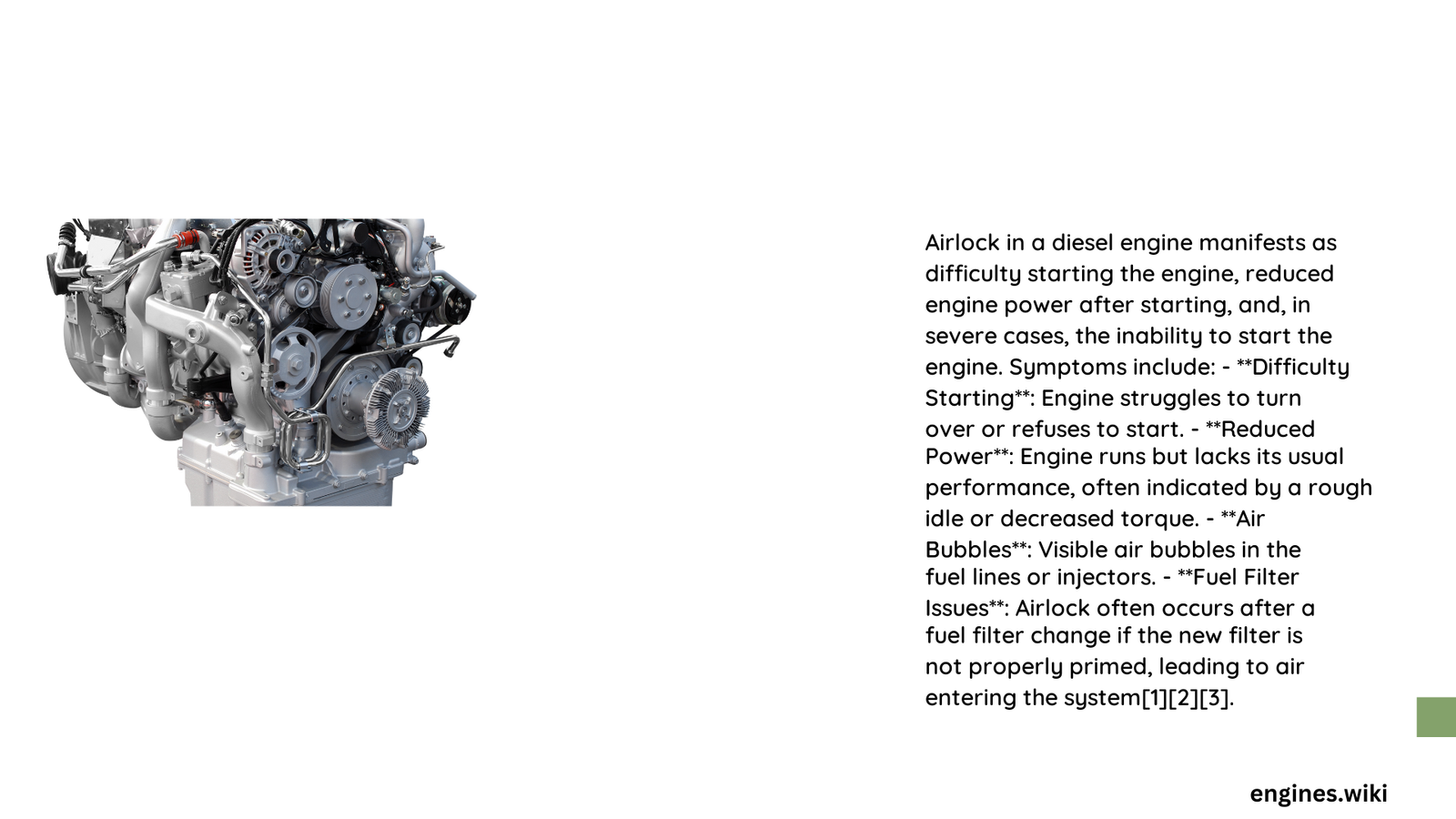Airlock Diesel Engine Symptoms: A Comprehensive Technical Overview
Diesel engines can experience performance disruptions due to air trapped within the fuel system, known as airlocks. These interruptions manifest through distinct symptoms that compromise engine functionality, potentially causing starting difficulties, reduced power output, and inconsistent fuel delivery. Understanding these symptoms is crucial for timely diagnosis and prevention of extensive engine damage.
What Are the Primary Indicators of Diesel Engine Airlock?
Airlock diesel engine symptoms emerge through multiple mechanical and performance-related signals:
Performance Manifestations
- Starting Challenges: Engine struggles or fails to start
- Power Reduction: Noticeable decrease in overall engine performance
- Fuel Delivery Inconsistency: Irregular fuel flow and combustion patterns
Diagnostic Pressure Indicators
| Pressure Range | Interpretation | Recommended Action |
|---|---|---|
| Below 52 PSI | Potential Airlock | Immediate System Bleeding |
| 53-73 PSI | Normal Operational Range | Monitor and Maintain |
| Above 74 PSI | Potential Fuel System Overpressure | Professional Inspection |
How Do Airlocks Develop in Diesel Engines?
Airlocks typically occur through several mechanisms:
- Fuel System Maintenance
- Incomplete bleeding after filter replacement
- Extended periods of vehicle inactivity
-
Low fuel levels creating air pockets
-
Mechanical Vulnerabilities
- Damaged fuel lines
- Compromised seals
- Worn fuel system components
What Diagnostic Steps Resolve Airlock Issues?
Systematic Troubleshooting Approach
- Fuel Pressure Assessment
- Utilize professional-grade diagnostic scanner
- Measure fuel rail pressure during cranking
-
Compare readings against manufacturer specifications
-
Visual Inspection Protocol
- Examine fuel lines for visible damage
- Check connection integrity
-
Verify seal conditions
-
System Bleeding Technique
- Loosen injector lines
- Manually pump fuel system
- Observe consistent fuel flow without air bubbles
What Prevention Strategies Minimize Airlock Risks?
Proactive maintenance significantly reduces airlock occurrence:
- Regular Fuel Filter Replacement
- Follow manufacturer-recommended intervals
- Use high-quality filtration components
-
Ensure complete system bleeding post-replacement
-
Fuel Quality Management
- Use premium diesel fuel
- Implement water separation techniques
- Store vehicle with adequate fuel levels
Technical Recommendations for Long-Term Reliability
Advanced Mitigation Strategies
- Install supplemental fuel filtration systems
- Implement periodic fuel system pressure testing
- Consider professional diagnostic evaluations annually
Cost and Time Considerations
| Maintenance Activity | Estimated Duration | Approximate Cost |
|---|---|---|
| Basic System Bleeding | 30-60 minutes | $50-$100 |
| Comprehensive Diagnostic | 1-2 hours | $150-$300 |
| Component Replacement | 2-4 hours | $200-$500 |
Expert Insights
Professional diesel mechanics emphasize early symptom recognition as the most effective strategy against extensive engine damage. Timely intervention can prevent costly repairs and maintain optimal vehicle performance.
Conclusion
Understanding airlock diesel engine symptoms requires technical knowledge, systematic diagnostics, and proactive maintenance. By recognizing early warning signs and implementing strategic prevention techniques, diesel vehicle owners can ensure reliable, efficient engine operation.

